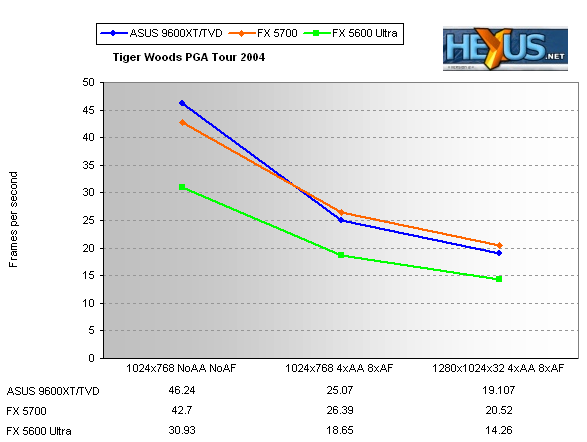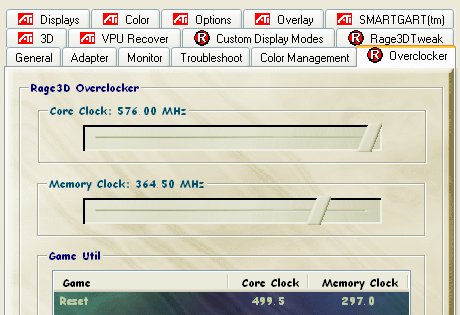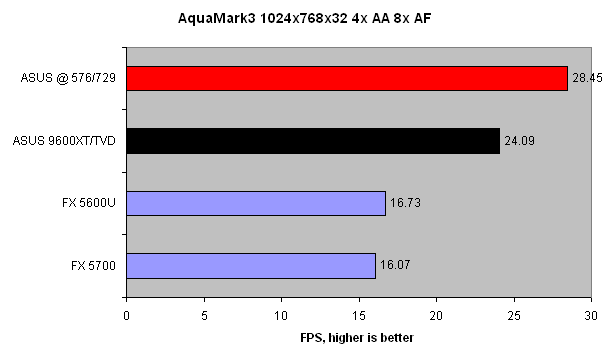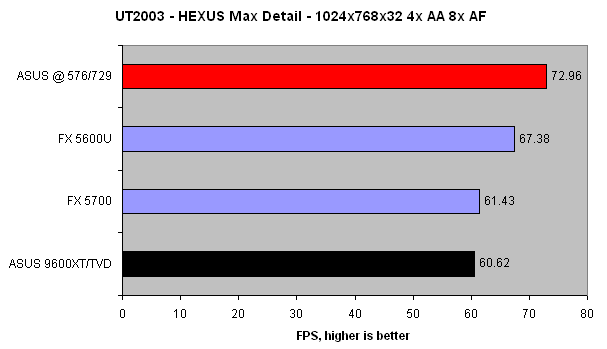TW2004, overclocking tests
- Author: EA Sports
- DirectX Class: 9.0
- Pixel and Vertex Shaders: Yes (unknown versions or amount of effects)

Tiger Woods PGA Tour 2004 is perhaps the most scintillating golfing title available on the PC as of now. Realistic-looking courses, attention to detail and damn engrossing gameplay makes one want to play it to completion. The test here was to measure the average FPS, via FRAPS 2.0, of a hole-in-one replay at the Bethpage course. The FX 5600 Ultra doesn't fare so well, and the ASUS card produces a solid frame-rate at the default test resolution. Please note that the benchmark was limited to a maximum of 1280x1024x32 on ATI cards. That's why the maximum resolution has been changed from the regular 1600x1200x32.
An interesting test of the cards' potential in a modern game.
Overclocking
As we've shown earlier, the ASUS Radeon 9600XT/TVD is based on the new RV360 core. It uses a low capacitance black diamond insulator for higher core speeds. Remember that a number of regular 9600 Pros were able to hit 500MHz GPU speed with stock cooling. Therefore we had high hopes for this card. Those hopes were heightened with the prior knowledge that the test card used Samsung's excellent 2.8ns TinyBGA memory, as found on some 9800 Pro and even 9800XTs.
The bundled SmartDoctor 2 utility offers basic overclocking via sliders. The problem with it stems from the maximum permissible clocks of 530MHz GPU and 650MHz memory. Rage3D Tweak 3.9b was used to gauge just how far that card could go. It was tested inside the confines of a closed case with no extra fan-assisted cooling present.

The GPU slider is at maximum. PowerStrip was also used but the card began to have serious stability problems at anything over 580MHz core. So much so that the desktop became corrupted and the drivers had to be removed and installed to cure the problem. At 576MHz, however, everything was as smooth as a baby's bottom. The 2.8ns memory showed no artifacts at 729MHz DDR, and only the odd one at 740MHz. The final, overclocked speeds were tested using AquaMark3 at 1024x768x32 with 4x AA and 8x AF.
AquaMark3 and UT2003 were re-run at 1024x768x32 4x AA / 8x AF to highlight the gains from overclocking.

The ASUS loves this test at default speeds. It just moves further on in the distance once overclocked.

Right to the top of the class again. Wouldn't it have been nice if ATI had released the RV360 at default speeds of 550MHz / 700MHz ?.









